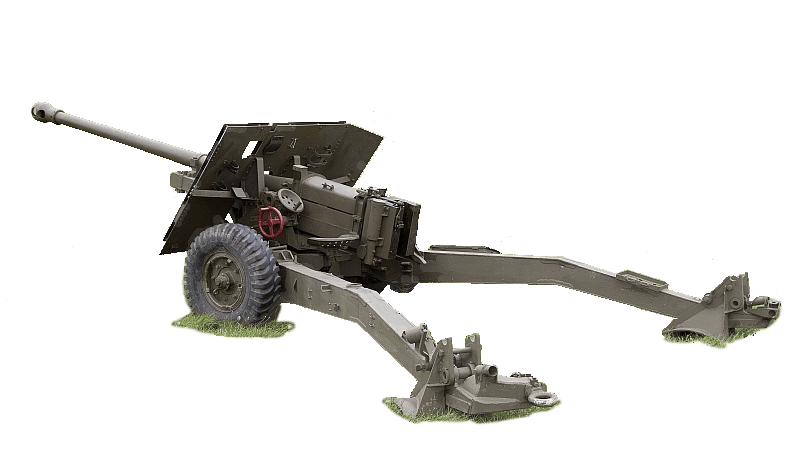
The 17 pounder Anti-Tank Gun was suggested as a replacement for the 6 pounder at a meeting in London in November 1940. As a result a design and wooden mock-up were authorised. This was done fairly quickly and despite some misgivings about the size of the gun, four pilot models were ordered in July 1941. With the pilot testing completed and final decision on production made, the 17 pounder was formally approved for service on the 1st May 1942.
Although the gun was a straightforward design with semi-automatic breech, the carriage design caused some delays in production. The two wheeled, split trail design had to be quite massive to withstand the gun’s powerful recoil. This was in the Autumn of 1942 and Army Intelligence had heard about the new German Tiger tank about to make an appearance in North Africa. The 17 pounder Gun was the only one likely to deal with the Tiger at reasonable ranges. It became urgent therefore to get the available guns on to some sort of carriage as soon as possible.
As a stop-gap a barrel was mounted on a standard 25 pounder carriage and test fired in September 1942. The performance was within acceptable limits and so a number of guns were mounted and sent to North Africa late in the year. They were used sucessfully and help back the enemy until the correct gun and carriage could be supplied.
Variants of the gun were used in tanks, on Royal Navy landing craft and as two Self Propelled guns for the Royal Artillery. These were the Archer, based on the chassis of the Valetine Tank and a conversion of the American 3 inch M10 to the 17 Pounder Anti-Tank Gun.
Gun
| Mark 1 | Original service issue with muzzle brake |
| Mark 2 | As Mk 1 but with Muzzle Counterweigh instead of Brake. For use in tanks. Counterweight replaced by Muzzle Brake from March 1944 |
| Mark 3 | Mk 1 with automatic loader. For RN in turret mount on Landing Craft Gun (M) |
| Mark 4 | For tanks. As Mk 1 but new breech ring with horizontal breech |
| Mark 5 | For US M10. As Mk 1 but alterations to breech ring |
| Mark 6 | As for Mk 4 but difference in breech ring & semi-auto gear. Shorter breech block. For tanks |
| Mark 7 | As for Mk 4 but difference in breech ring. Shorter breech block. For tanks |
Data
| Weight of gun & breech mechanism | 1,822 lbs |
| Total Length | 180.35 inches |
| Length of Bore | 165.45 inches (55 calibres) |
| Rifling | 20 grooves, uniform Right Hand 1/30 |
| Breech Mechanism | Vertical sliding block, semi-automatic, percussion fired |
| Elevation | -6° to +16½° |
| Traverse | 30° Left & Right |
| Recoil System | Hydro-pneumatic, constant, 40 inches |
| Weight in action | 4,624 lbs |
Performance
Firing standard 15.4 lb HE Shell
| Muzzle Velocity | 2,875 feet per second |
| Maximum Range | 10,000 yards |
Firing 16 lb 15 oz AP Shot
| Muzzle Velocity | 2,900 feet per second |
| Penetration | 109 mm at 1,000 yards, 30° angle |
Firing 17 lb APC Shot
| Muzzle Velocity | 2,900 feet per second |
| Penetration | 118 mm at 1,000 yards, 30° angle |
Firing 17 lb 10 oz APDS Shot
| Muzzle Velocity | 3,950 feet per second |
| Penetration | 231 mm at 1,000 yards, 30° angle |
Ammunition
| Shell, High Explosive, Mark 1T | Nose fuzed shell filled with TNT |
| Shot, Armour Piercing, Mark 3T | Plain Steel Shot with base tracer |
| Shot, Armour Piercing Cap, Mark 4T | Similar to 3T but with penetrative cap. |
| Shot, Armour Piercing Discarding Sabot, Mark 1T | Tungsten Carbide core in a light steel sheaf with base tracer. This was enclosed in a light alloy sabot splitting into 4 sections on firing &discarded at the muzzle |
